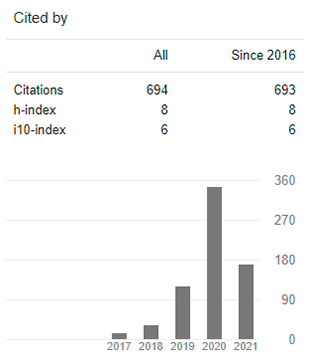Develop Didactic Actions for the Conservation of the Petroglyphs of the Municipality Antonio José de Sucre Barinas 2016
DOI:
https://doi.org/10.29394/scientific.issn.2542-2987.2017.2.3.11.209-225Keywords:
didactic activities, conservation, petroglyphsAbstract
This esearch work is focused on the development of training actions for the conservation of the petroglyphs in the municipality Antonio José de Sucre Barinas 2016. The methodology is qualitative in nature in which stands the Ethnography as via access to the particular characteristics of the subject of study, are addressed from the perspectives of three key informants included a close neighbor, a tour guide and a chronicler of the municipality near the geographical space where the petroglyphs are located; This will require to collect information through the application of the technique of the interview using the questionnaire as an instrument of data collection. In that sense, this study seeks to promote actions aware about the care and respect for ancestral engravings and heritage originating in the native cultures of the region, thus preserving the air physical to encourage tourism and recreation in these areas.
Downloads
References
Ary, R. (2004). Introducción a la investigación pedagógica. México: Editorial interamericana.
Bonell, H. (2005). Los petroglifos como formas de comunicación simbólica reportaje investigativo. Universidad de los Andes Dr. Pedro Rincón Gutiérrez Departamento Comunicación Social. Táchira, Venezuela. Recuperado de: http://servidor-opsu.tach.ula.ve/tesis_acro/gn799_p4b6/bonell_h.pdf
Constitución Nacional de la República Bolivariana de Venezuela (1999). Artículo Nº 98. Venezuela.
Criollo y Rojas (1995). Petroglifos en Venezuela. Museo de Arte de Caracas, Venezuela. Recuperado de: http://petroglifos.ve.tripod.com
Fernández, G., y Guzmán, A. (2013). El patrimonio histórico-cultural revalorizado en el marco de un desarrollo sustentable del turismo. Argentina. [Documento en línea]. Recuperado de: http://webcache.googleusercontent.com/search?q=cache:http://www.equiponaya.com.ar/turismo/congreso/ponencias /aldo_ramos.htm&gws_rd=cr&ei=FFoHWJfhGMW9edX3sPgO
García, Z. (2007). Estrategias educativas para la valoración del patrimonio cultural en la educación básica en Venezuela. Universidad de los Andes.
Infopedia Barinas (2007a). Patrimonio Arqueológico del municipio Antonio José de Sucre. Versión ALFA. Barinas, Venezuela. Recuperado de: http://www.barinas.net.ve/infopedia/ARTICULOM-210-Patrimonio_Arqueologico_del_municipio_Antonio_Jose_de_Sucre-26-30.htm
Infopedia Barinas (2007b). Orígenes de Bum Bum ¡Tierra mágica! en el municipio Antonio José de Sucre. Versión ALFA. Barinas, Venezuela. Recuperado de: http://www.barinas.net.ve/infopedia/ARTICULOM-161-Origenes_de_Bum_Bum_Tierra_magica_en_el_municipio_Antonio_Jose_de_Sucre-26-25.htm
Marshall, C., & Rossman, G. (1989). Designing qualitative research. Newbury Park, CA: Sage.
Moser, H., y Ornauer, H. (Eds.) (1978). Internationale Aspekte der Aktionsforschung. München. Kösel Verlag.
Obispo, M., Hurtado, L., Santana, V., Contreras, M., y Jiménez, J. (2007). Arte Rupestre del Estado Barinas, Venezuela. [Documento en línea]. Recuperado de: http://petroglifos6.blogspot.com
Palella y Martins (2010). Investigación cuantitativa. Universidad Yacambu.
Tylor, E. (1975). “La ciencia de la cultura”, a KAHN, J.S. (comp.): El concepto de cultura: textos fundamentales, p. 29-46. Barcelona: Anagrama.
UNESCO (2011). Patrimonio cultural Un Enfoque Diverso y Comprometido. México, D.F. Recuperado de: http://www.unesco.org/new/fileadmin/MULTIMEDIA/FIELD/Mexico /pdf/CIRO_seguridad_p.pdf
Downloads
Published
How to Cite
Issue
Section
License
The content of the journals of this site, are under a Creative Commons Attribution-Noncommercial-Share Alike 4.0 International License.













